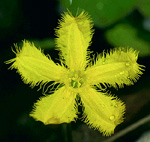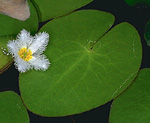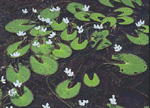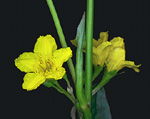 |
All members of this small, cosmoplitan family are marsh or water-plants; they may be found almost throughout Australia in suitable habitats except in desert regions where waterbodies are only ephemeral.
Characteristic features of the family Menyanthaceae in Australia include: - marsh plants with erect, emergent leaves (sometimes growing in wet heathlands) or water plants with floating leaves and flowers
- leaves with sheathing petioles, linear or elliptic to heart-shaped blades and usually with dark gland-dots
- flowers showy, yellow or white (rarely pale pink), with 5 petals fused below and often fringed with hairs along the free margins
- fruit a capsule splitting at the apex, or indehiscent
Description
Annual or perennial aquatic herbs rooted in the substrate with their leaves emergent. Perennating by rhizomes or crowns. Vegetative reproduction by rhizomes or stolons. Internal secretions not obvious. Plants glabrous. Leaves alternate and spiral, or distichous; all or mostly basal, petiolate. Stipules absent. Lamina simple, symmetric, lanceolate, ovate, elliptic or orbicular; base cuneate, rounded, cordate or hastate or sagittate; margins entire, crenate or dentate, ±flat; one-veined, or the venation pinnate, or palmate, with the midrib conspicuous, and the tertiary venation reticulate; surfaces dark- or pellucid-punctate or not punctate; herbaceous or leathery. All the flowers bisexual. Inflorescences axillary, consisting of capitula, racemes, panicles or solitary flowers, or apparently of umbels. Bracts present. Flowers odourless, sessile or stalked. Floral disc absent; nectaries absent or present on the carpels. Perianth regular, of 2 dissimilar whorls. Calyx segments free or fused, with 4–5 sepals or lobes, imbricate in bud; calyx bell-shaped or funnel-shaped, herbaceous. Corolla segments fused, with (3–) 4–5 (–7) lobes, alternating with the sepals or calyx lobes, valvate in bud; corolla wheel-shaped, white, yellow or orange, without contrasting markings, membranous; claws absent; lobes ±entire or ciliate or fimbriate. Fertile stamens 4 or 5, opposite to the sepals or calyx lobes, at least partly fused to the corolla, free of the ovary and style, distinct from each other, all ±equal. Anthers dorsifixed, not versatile, opening inwards by longitudinal slits, 2-celled. Ovary superior and sessile, or part-inferior. Carpels 2–3 or 5, fused; ovary with 1 locule. Style terminal, single and unbranched, or single and branched above with the stigma fimbriate or lobed. Ovules 2–numerous, stalked or sessile; placentation parietal. Fruit a dry dehiscent capsule with irregular or valvular dehiscence; the perianth on the maturing fruit rotting or liquefying, or dry and persistent. Disseminule micro-surface ±smooth, colliculate or tuberculate, cream, yellow, brown, grey or black, glossy or dull. Seeds 2–numerous per fruit. Aril present or absent. Cotyledons 2. Embryo straight.
(Note: this description has been generated from the coded data compiled for the key. Any errors in the key data will be reflected in the descriptions.)
A treatment of the family Menyanthaceae has not yet been published in the Flora of Australia. It will appear in Volume 30.
Australian genera of Menyanthaceae (as recognised for the Flora of Australia)
Liparophyllum
Nymphoides
Villarsia

|
  |

Nymphoides geminata (flower)
Photo: R.Hotchkiss © ANBG

Nymphoides indica (flower)
Photo: M.Fagg © ANBG

Nymphoides sp. (habit)
Photo: J.Wrigley © ANBG

Villarsia exaltata (flowers)
Photo: M.Fagg © ANBG
|

| |